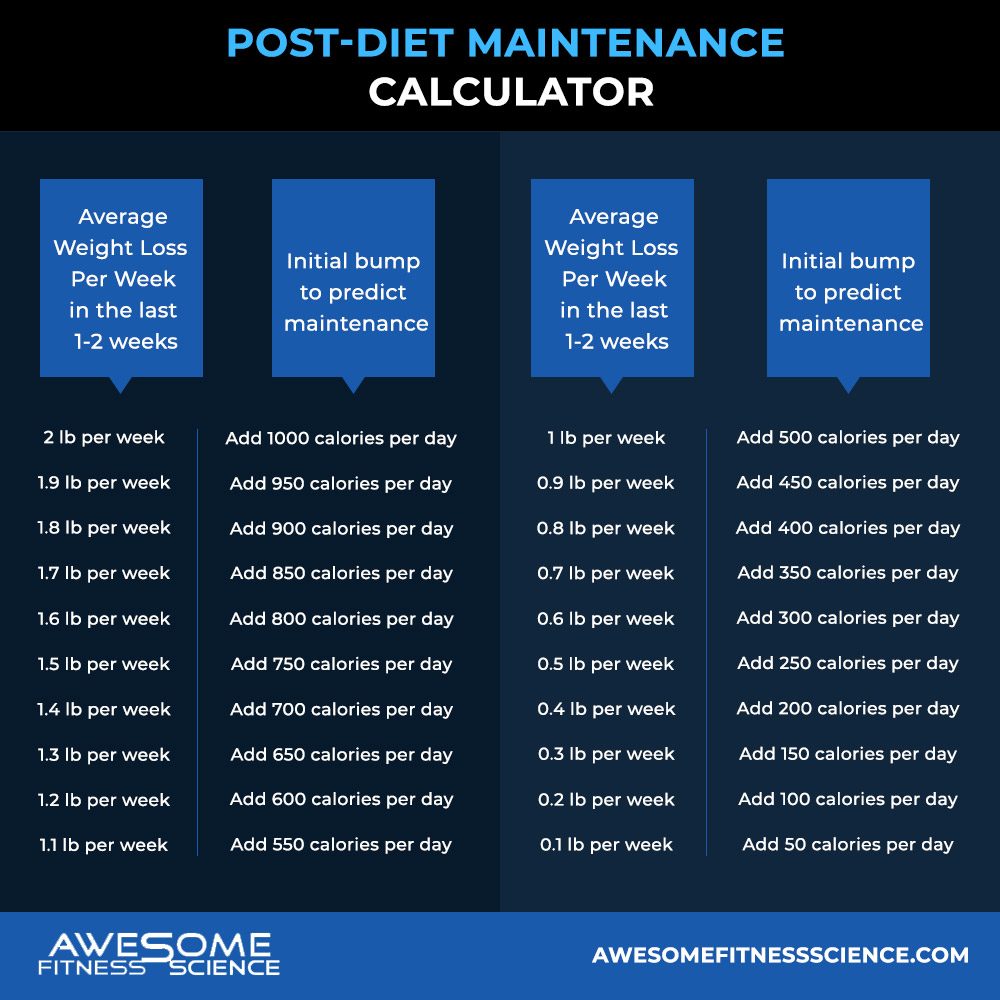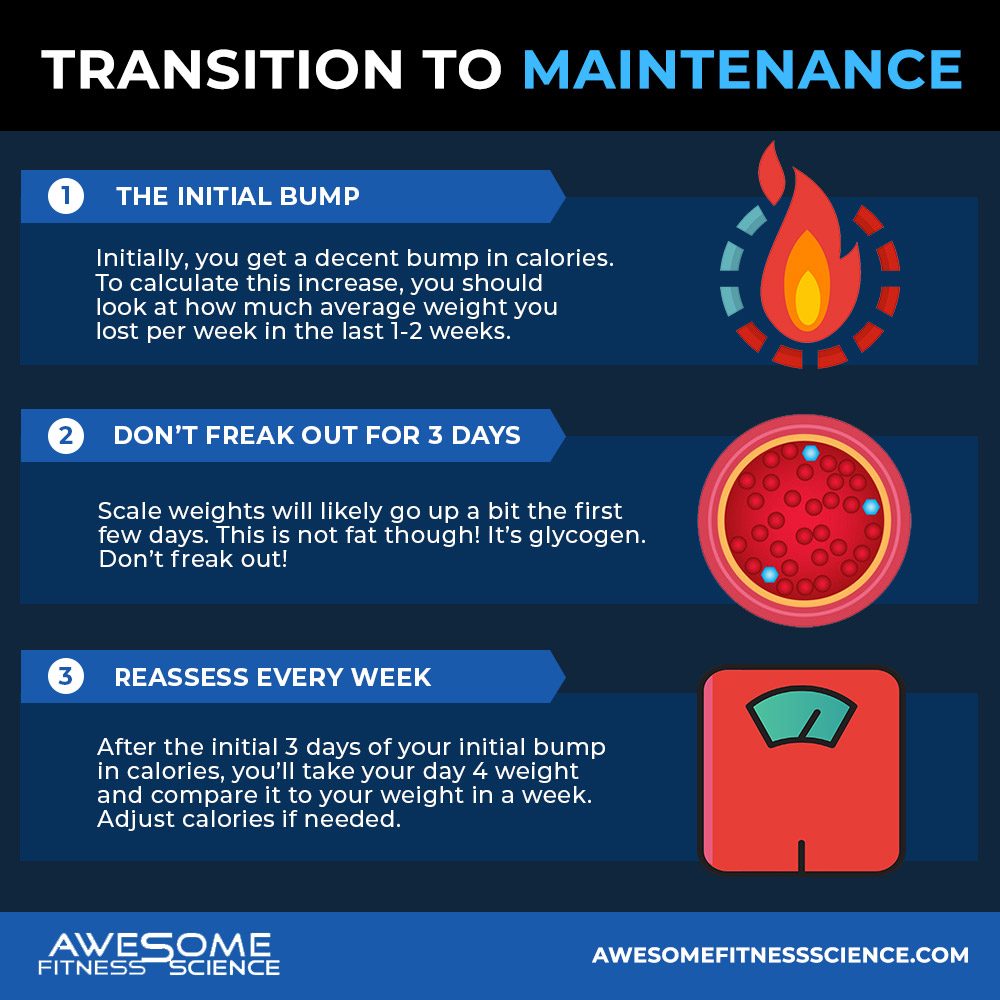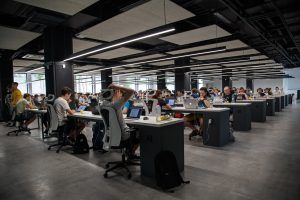
How to Stretch for Muscle Growth
How to Stretch for Muscle Growth Stretching is the best thing you’re not doing for muscle growth. Yes you read that correctly. Stretching, the thing

So you’re done with dieting? Cool, now it’s time to transition to maintenance because losing weight is only half the battle. Maintaining your new bodyweight is the other (arguably more important) half.
It’s time to transition out of a diet when one of the following applies to you:
Regardless, the good news is that you can eat slightly more at maintenance. With maintenance, you’re no longer in a caloric deficit where energy/fuel is being pulled away from you. So yay, for slightly more food!
To be clear though, your post diet maintenance is not the same as your pre-diet maintenance because you are now a new lighter person. If you ate at the maintenance you had before you dieted down, you’d eventually unravel back up to that weight which you obviously don’t want.
Anyways, here’s how to go about everything.
Initially, you get a decent bump in calories. To calculate this increase, you should look at how much average weight you lost per week in the last 1-2 weeks.
1 lb of fat is basically 3500 calories. If you lost an average 1 lb per week, you can add 500 calories per day to exit your current deficit. If your brain is too lazy to do the math, I don’t blame you. I made a chart below just for you.

Based on your recent average weight loss, that’s how much your initial caloric bump should be. If you setup your original diet correctly, your protein should already be optimal. The caloric bump can come from carbs/fat. You can even have more protein if you’re simply obsessed with animal flesh and like spending more money.
But the point is the exact macro you choose to bump up doesn’t matter much in most cases.
As I’ve mentioned in a previous article, during a diet, your energy balance is incomplete. Your love handles not only lose fat, but your muscles are short of glycogen (stored sugar that makes them look full and perform well).
When you transition out of a diet, glycogen gets refilled which draws water into your muscles. More food also means more average food weight within your gut at any given time.
This means the scale will likely go up a bit the first few days. This is not fat though! Don’t freak out! Keep eating with your initial bump. You need to officially exit the deficit for metabolic adaptations to recover as well so energy expenditure ramps back up which is a good thing.
So while all this is happening in 3 days, the scale is irrelevant. You don’t have to even weigh in, especially if you get irrationally emotional. Freaking out over scale spikes will cause you to restrict calories again and you’ll never learn how to maintain your fat loss.
So chill your balls or ovaries. You’re not ballooning up and getting fat. You can even take waist measurements during this time and realize they’re relatively the same despite potentially being up a pound or two.
You might not even gain any scale weight as energy expenditure and exercise performance ramps up, but you have to give it the full 3 days to objectively know.
After the initial 3 days of your initial bump in calories, you’ll take your day 4 weight and compare it to your weight in a week.
If you’re roughly maintaining within 0.5 pounds, you’re at maintenance and can stay at these calories or push your calories another bump 100-300 calories to see if you can get away with more food.
If you’re still losing weight consistently, you’ll need another bump of 100-300 calories to get to maintenance.
If there’s a trend that you’re gaining more than 0.5 pounds at this point, you can reduce your intake by 50-200 calories.
After 1-2 assessment(s), you’ll likely find your desired maintenance sweet spot. This entire process of transitioning to maintenance should take 2-3 weeks at most. While it’s a short and relatively simple protocol, people make many common mistakes.

This brings me to 3 key pieces of practical advice that you tattoo in your brain:
Let’s say you want to transition from dieting straight to a bulk. Contrary to popular belief, this is a valid approach that’s suited for more advanced lifters. There is actually no physiological incentive for having to stop by maintenance for some arbitrary amount of time if you plan on bulking anyways.
Maintenance is still a crucial for beginners who’ve never practiced the behaviors and mindset of it.
But lean advanced lifters who already know how to maintain their weight and require a surplus to further enhance their physique should transition straight to a surplus post diet (1).
To do so is similarly simple. You take the same approach as transitioning to maintenance, but with the following changes:
Getting lean and attaining abs is cute, but staying lean and keeping your abs is more important. Now you know how to do so. Once you lock in your range of maintenance calories is, you might be wondering if you have to track calories forever to maintain these results?
Fortunately, you don’t have to and I’ll show you how to transition away from tracking while keeping your results in a future article. You can email me cute dog pictures to incentivize me to get that article done sooner.
But for now, share this article with a friend that would find it helpful.
1.
Slater, Gary John, et al. “Is an Energy Surplus
Required to Maximize Skeletal Muscle Hypertrophy Associated With Resistance
Training.” Frontiers, Frontiers, 2 Aug. 2019,
www.frontiersin.org/articles/10.3389/fnut.2019.00131/full.
Sign up for AwesomeFitnessScience Weekly. You’ll get juicy insider secrets, updates, and stories.

How to Stretch for Muscle Growth Stretching is the best thing you’re not doing for muscle growth. Yes you read that correctly. Stretching, the thing

Here’s How Often You Should Take Desk Breaks Many of us sit daily inside a car or an office for hours upon end. I bet

MSG is often criticized for numerous health detriments. Some claims include headache, sweating, heart palpations, burning sensations, nausea, brain toxicity, asthma, liver damage, and the death of all your pets.